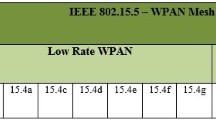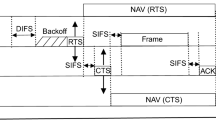Abstract
In this paper, a novel mechanism for access control and resource allocation in a parent/child IEEE 802.15.3 network is proposed. The main objective is twofold; first the idea of using a dynamic superframe size that ensures the efficient use of the superframe is implemented; second, two approaches for resource allocation among child PicoNet Coordinators (PNCs) and DEVices (DEVs) based on the dynamic superframe idea are proposed. These approaches, referred to as “Algorithm with utilization threshold” and “Algorithm with threshold and service differentiation”, are studied in comparison with a basic approach. They share the concepts of the dynamic superframe size, the prioritization of child PNCs over DEVs and the admission control strategy. They are then differentiated by applying the superframe utilization threshold concept in the “Algorithm with utilization threshold” and the addition of service differentiation in the “Algorithm with threshold and service differentiation”. The superframe utilization threshold allows more devices to access the shared superframe, whereas the service differentiation guarantees the quality of service (QoS) requirements for real-time traffic requests. The proposed mechanism seeks to apply a compromise between the devices satisfaction, the QoS requirements and the requests rejection rate to induce fairness and service differentiation. Simulation results show that the proposed algorithms provide high satisfaction for both child PNCs and DEVs with greater satisfaction for the child PNCs. The superiority of using the dynamic superframe size over the fixed superframe size is also shown by the efficient use of the superframe and the minimized delay between the channel time allocations of the same device in the subsequent superframes.




















Similar content being viewed by others
References
IEEE Standard 802.15.3-2003. (2003). Part 15.3: wireless medium access control (MAC) and physical layer (PHY) specifications for high rate wireless personal area networks (WPANs). (pp. 1–315).
IEEE Standard 802.15.4-2006. (2006). Part 15.4: Wireless LAN medium access control (MAC) and physical layer (PHY) specifications for low-rate wireless personal area networks (LR-WPANs).
Kim, S., & Cho, Y. (2005). Scheduling scheme for providing QoS to real-time multimedia traffics in high-rate wireless PANs. IEEE Transactions on Consumer Electronics, 51(4), 1159–1168.
Liu, X., Dai, Q., & Wu, Q. (2004). Scheduling algorithms analysis for MPEG-4 traffic in UWB. In 2004 IEEE 60th Vehicular Technology Conference.
Kim, B.-S., Kim, S., Fang, Y., & Wong, T. (2010). Feedback-assisted mac protocol for real time traffic in high rate wireless personal area networks. Wireless Networks, 16(4), 1109–1121.
Rangnekar, A., & Sivalingam, K. (2006). Qos aware multi-channel scheduling for IEEE 802.15.3 networks. Mobile Networks and Applications, 11(1), 47–62.
Tseng, Y. H., Wu, E. H. K., & Chen, G.-H. (2003). Maximum traffic scheduling and capacity analysis for IEEE 802.15.3 high data rate MAC protocol. IEEE Vehicular Technology Conference, 3, 1678–1682.
Mangharam, R., Emirian, M., Rajkumar, R., & Raychaudhuri, D. (2004). Size matters: size-based scheduling for MPEG-4 over wireless channels. In SPIE & ACM Proceedings in Multimedia Computing and Networking (pp. 110–122).
Boggia, G., Camarda, P., & Grieco, L. A. (2010). Scheduling channel time allocations in 802.15.3 WPANs for supporting multimedia applications. Wireless Communications and Mobile Computing, 10(5), 596–608.
Chen, X., Xiao, Y., Cai, Y., Lu, J., & Zhou, Z. (2006). An energy diffserv and application-aware MAC scheduling for VBR streaming video in the IEEE 802.15. 3 high-rate wireless personal area networks. Computer Communications, 29(17), 3516–3526.
Kuo, W. K., & Lien, S. Y. (2009). Dynamic resource allocation for supporting real-time multimedia applications in IEEE 802.15.3 WPANs. IET Communications Journal, 3(1), 1–9.
Tseng, Y.-H., Wu, H.-K., & Chen, G.-H. (2007). Scene-change aware dynamic bandwidth allocation for real-time VBR video transmission Over IEEE 802.15.3 wireless home networks. IEEE Transactions Multimedia, 5, 642–654.
Jung, S. B., Yim, S.-B., Lee, T. J., June, S.-D., Lee, H. S., Kwon, T. G., & Cho, J. W. (2006). Multipiconet formation to increase channel utilization in IEEE 802.15.3 high-rate WPAN. Springer-Verlag Lecture Notes in Computer Science, 3392, 1041–1049.
Jung, S., Kim, H., Yim, S., & Lee, T. (2007). Channel time allocation and routing algorithm for multi-hop communications in IEEE 802.15.3 high-rate WPAN mesh networks. International Conference on Computational Science (ICCS’07) (pp. 457–465).
Da Costa, F. (2004). Dynamic beacon alignment in simultaneously operating piconets (SOP) using the heart beat approach. IEEE Standard P802.15-04/135r0.
Xue, P., Gong, P., & Kim, D. (2008). Enhanced IEEE 802.15.3 MAC protocol for efficient support of multiple simultaneously operating piconets. IEEE Transactions on Vehicular Technology, 57(4), 2548–2559.
Sindian, S., Khalil, A., Samhat, A., Crussière, M., & Hélard, J.-F. (2014). Resource allocation in high data rate mesh WPAN: A survey paper. Wireless Personal Communications, 74(2), 909–932.
Author information
Authors and Affiliations
Corresponding author
Rights and permissions
About this article
Cite this article
Sindian, S., Hélard, JF., Samhat, A.E. et al. Resource allocation mechanism in IEEE 802.15.3 parent/child model. Wireless Netw 21, 1863–1877 (2015). https://doi.org/10.1007/s11276-015-0892-5
Published:
Issue Date:
DOI: https://doi.org/10.1007/s11276-015-0892-5




